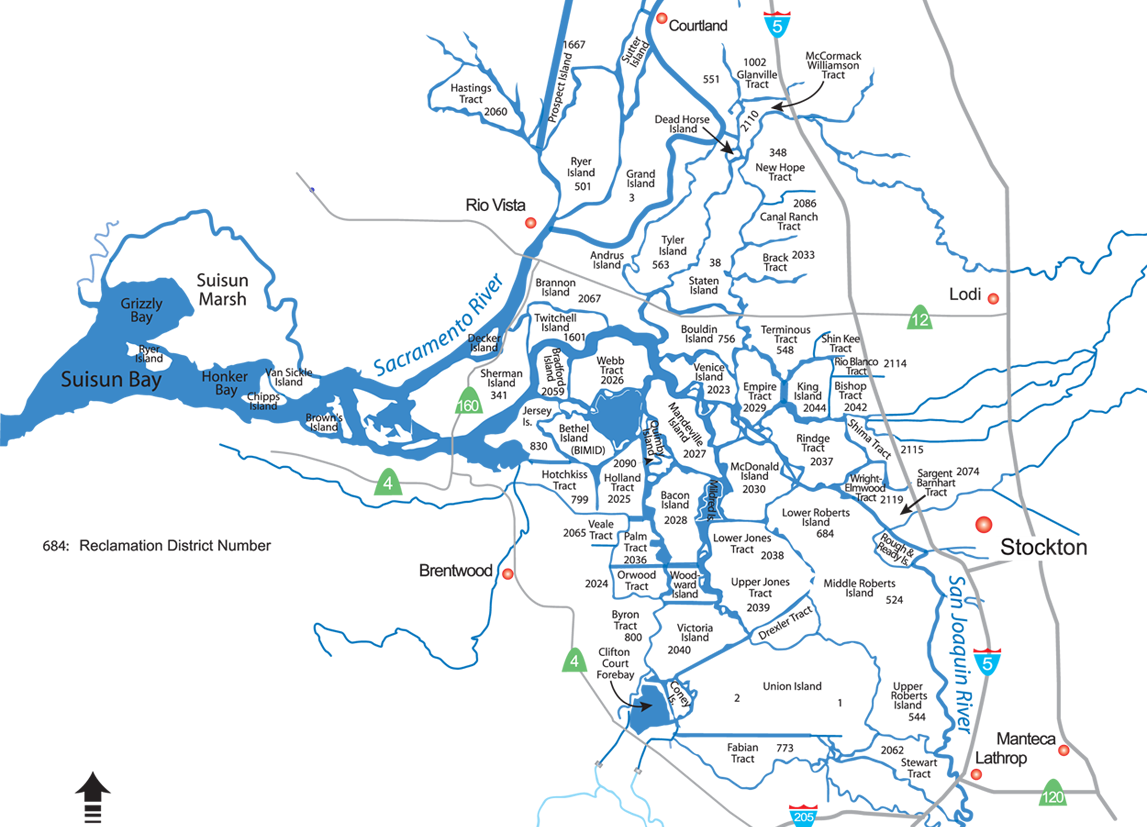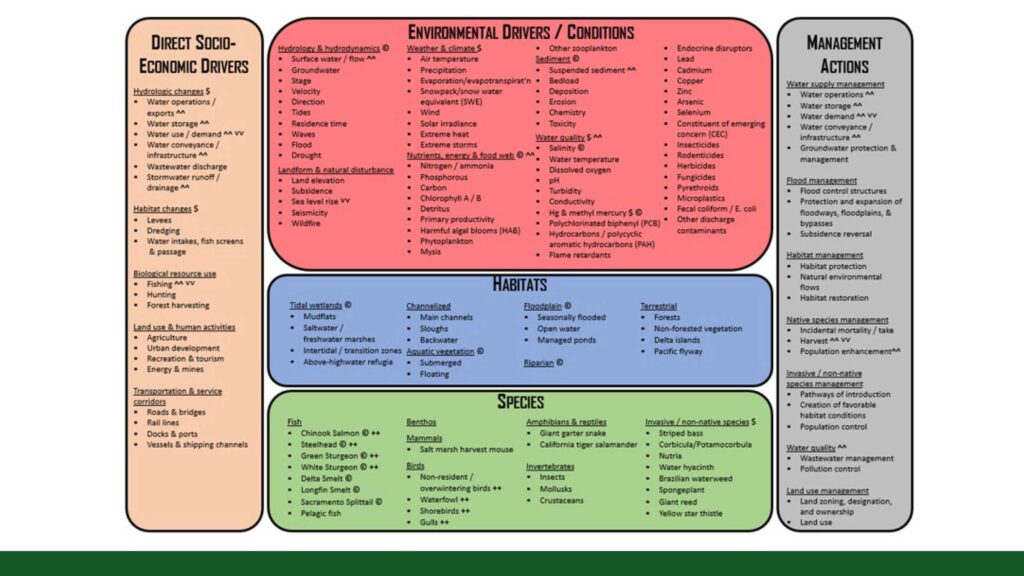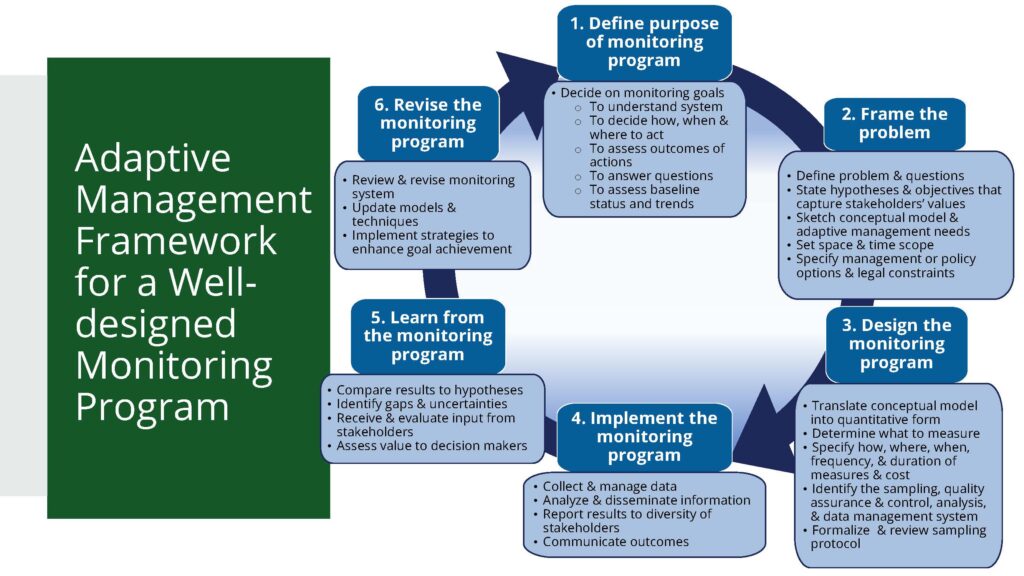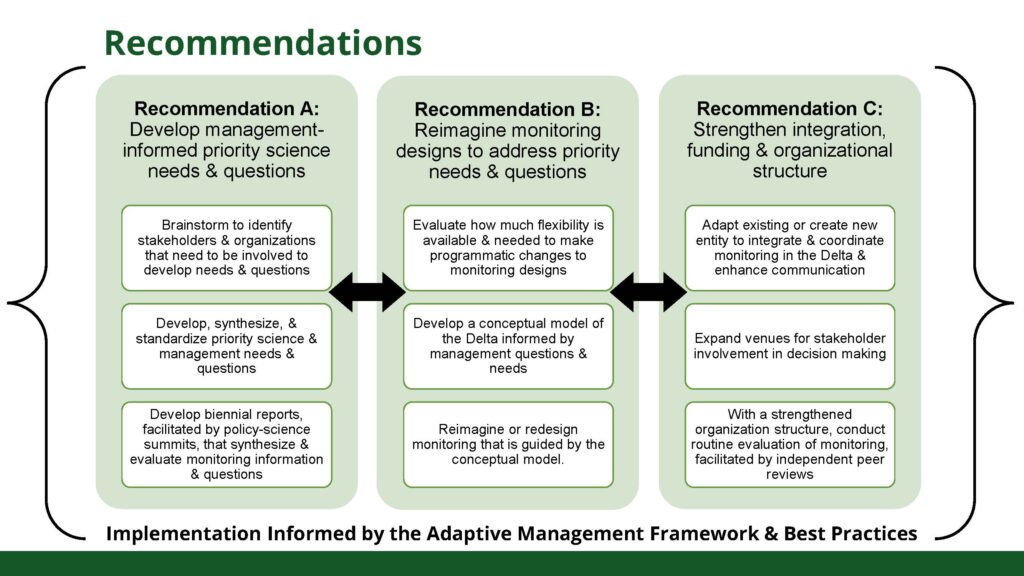At the April meeting of the Delta Stewardship Council, Delta Lead Scientist Dr. Laurel Larsen highlighted research on juvenile salmon behavior in the presence of predators, and updated the Council on the activities of the Delta Science Program, the 2022-2026 Science Action Agenda was accepted by the Council, and the Delta Independent Science Board presented the results of their review of the Delta monitoring enterprise.
Article spotlight: Environmental conditions and Juvenile Chinook salmon antipredator behavior
At the April meeting of the Delta Stewardship Council, Delta Lead Scientist Laurel Larsen wrapped up her series of article spotlights featuring the work of Delta Science Fellows funded by the Council by highlighting a recent paper by Megan Sabal, a Ph.D. candidate at UC Santa Cruz.
Ms. Sabal’s work is relevant to the management of Chinook salmon populations and predation. Predation on native species by non-native species such as striped or largemouth bass is one of the most poorly understood factors affecting population levels. This is particularly critical because such a large fraction of the juvenile salmon that hatch in the Delta’s tributaries do not survive their passage through the Delta to the ocean to continue the next phase of their lifecycle. So filling the knowledge gap about the role that predation plays in juvenile Chinook salmon mortality was established as a priority both in the 2017 to 2021 Science Action Agenda (SAA) as well as the recently released 2022 to 2026 Science Action Agenda.
Action four of the 2017-21 Science Action Agenda and management need five of the current Science Action Agenda are both about understanding interactions between stressors and managed species and their ecological communities. One of the management questions associated with management need five of the current Science Action Agenda is where and under what conditions (habitat, water temperature, food web interactions, and flow) do we find increased predation pressure on native aquatic species in the Delta? And then how can those conditions be altered to reduce this pressure?
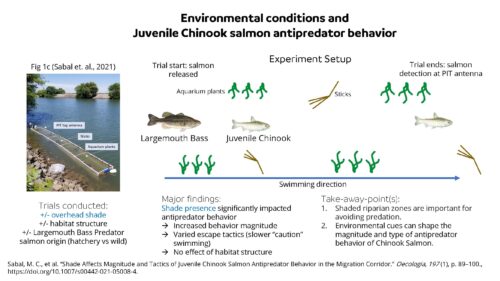 The study by Megan Sabal addressed this very question. Ms. Sabal and her research team were interested in addressing how habitat influences predation by looking at how juvenile Chinook salmon’s behavioral response to the presence of a striped bass predator was modified in different types of habitat. So to address this question, they set up flumes, which are open-ended enclosures that were essentially miniature fish racetracks. The flumes were set up in different types of habitat, such as the presence or absence of shade and the presence or absence of submerged sticks, vegetation, and other underwater structures.
The study by Megan Sabal addressed this very question. Ms. Sabal and her research team were interested in addressing how habitat influences predation by looking at how juvenile Chinook salmon’s behavioral response to the presence of a striped bass predator was modified in different types of habitat. So to address this question, they set up flumes, which are open-ended enclosures that were essentially miniature fish racetracks. The flumes were set up in different types of habitat, such as the presence or absence of shade and the presence or absence of submerged sticks, vegetation, and other underwater structures.
In about half of those trials, a bass was lurking in the flume, the juvenile salmon were introduced at the upstream end of the flume, and the amount of time it took them to swim to the other end was recorded. The research team also compared the behavior of wild to hatchery salmon to test the hypothesis that hatchery-raised chinook salmon might not benefit from the evolutionary behavioral adaptations developed by wild reared chinook salmon over generations.
“What they found is that shade is what made the biggest difference in the behavior of juvenile salmon in the presence of a predator, and that salmon slowed substantially as they swam past the predators in shaded conditions,” said Dr. Larsen. “While this behavior may help them avoid predators, if it slows their migration through the Delta substantially, it could prolong their time in a risky environment.”
“They also found virtually no difference between wild and hatchery salmon, which is encouraging given our increasing reliance on hatchery operations for species recovery,” she continued. “While it is unclear at this point how the observed salmon behavior would extrapolate to the population level without additional studies of successful predation and where those occur, or the effects of travel time on survival probability, these studies do contribute to a growing body of understanding of the various factors that contribute to predation risk.”
Dr. Larsen noted that the study refuted the hypothesis that hatchery-raised salmon would have different behavior from the wild salmon in the presence of a predator. The other hypothesis was that the fish would exhibit different evasive behavior in different habitat types; however, they didn’t hypothesize how that behavior may be helpful or harmful.
“It could be that evasive behavior could help them avoid predators more effectively in the shade,” said Dr. Larsen. “But if they experience a lot of shade through their transit, it’s really going to slow them down as they move through the Delta, whereas they’re not just at risk of predation, but warm temperatures might be risky as well.”
The paper also discussed how additional studies would be needed to ascertain whether these behavioral changes are good or bad for the populations.
Read the article here: Shade Affects Magnitude and Tactics of Juvenile Chinook Salmon Antipredator Behavior in the Migration Corridor. Sabal Et Al., Behavioral Ecology, 2021.
Activities of the Delta Science Program
Delta salinity management workshop
The first in a series of workshops on salinity management in the Delta was held just last week. While Dr. Larsen said it’s too soon yet for a detailed report out, she noted there were over 200 registrants and as many as 149 participating at one time in the sessions. Dr. Larsen acknowledged the efforts of Karen Kayfetz and others on the organizing committee in organizing a successful event.
The participants included tribal groups, fishing groups, boating groups, and residents of the Delta – groups that aren’t always at the table. “It also provided a safe space to exchange conversations about diverse perspectives on salinity management, many of which are not typically represented in agency planning decisions,” said Dr. Larsen.
The series of workshops in 2022 is intended to kick off a collaborative adaptive management process for evaluating long-term trade-offs associated with alternative strategies for salinity management during drought, which she said was arguably the most challenging aspect of managing the Delta during drought.
The workshop included panel discussions, plenary sessions, and three breakout sessions that collectively framed the challenge of future salinity management in the context of climate change. Environmental justice and current laws and regulations were discussed. The workshop built towards a shared understanding of how salinity management affects different people, industries, and ecological systems. It helped identify knowledge gaps and gaps in resources such as models and certain assumptions that we’re making in models that could be priorities for future research directions.
The workshop also started conversations around goals for long-term adaptive management and laid the foundation for a scenario-based modeling exercise that will continue over the summer and be used to structure the discussion in the next workshop, scheduled for October 11-12, 2022. In addition, over the summer, focused workgroup meetings will be held with different stakeholder groups to gather input on a pilot or demonstration exercise on how we might use collaboratively developed modeling tools to compare alternative salinity management strategies, such as nature-based versus traditional engineering solutions and their impacts.
At the October workshop, participants will work to devise an action plan for a more comprehensive process of developing and comparing a fuller suite of scenarios as part of an adaptive management strategy for managing salinity.
Watch the workshop:
- Click here to watch Day 1 of the salinity management workshop.
- Click here to watch Day 2 of the salinity management workshop.
Upcoming CCST webinar on Delta salinity
On a related note, the Delta Science Program is partnering with the California Council on Science and Technology on an expert briefing as part of their Toward a Disaster Resilient California series. The briefing, titled Managing salinity in the California Delta in a changing climate, is scheduled for May 16 and will be moderated by Karen Kayfetz, Adaptive Management Program Manager with the Delta science program. The panel features DISB member Dr. Jay Lund, Dr. Brett Milligan, a professor in the Department of Human Ecology at UC Davis, and Dr. Nigel Quinn, a research group leader at Berkeley National Laboratory. Click here to register.
Ongoing Delta governance brown bag series
The second of three Delta governance brown bag webinars was held on April 13. The webinar focused on collaborative governance, and it highlighted how partnerships and decentralized structures and processes are used by government and non-government actors to influence decision-making. The panelists included Dr. Brett Milligan with UC Davis; Andrea Gerlach with the University of Arizona; Matthew Moore, a representative of the United Auburn Indian community; and Jessica Law with the Water Forum.
Watch the series:
Delta Lead Scientist: Ask Me Anything series
On May 2, the focus of the Delta Lead Scientist Ask Me Anything continued with a focus on social science featuring Dr. Jessica Rudnick, the California Sea Grant extension specialist within the Council as the cohost. They discussed the Delta residents survey, the social science community of practice, and other ongoing efforts to integrate social science into all aspects of Delta science. Dr. Larsen noted that, in the future, the series will be switching to a new format and aligning the Ask Me Anything with notable events rather than particular days of the month.
In the works: Delta modeling summit
The Delta Science Program is convening a modeling summit in the late summer of 2022. The modeling summit aims to bring together members of the Delta science and modeling community that are in agencies, consulting agencies, and academia to identify the next steps towards developing a modeling “Collaboratory” for the Delta.
A collaboratory is a term to describe a virtual center that facilitates the use, reproducibility, and transparency of models for planning and predicting future conditions in the Delta. A collaboratory would have cyberinfrastructure resources associated with it that will enable more ready integration of data with models, the integration or interoperation, or linking different models together, such as models for flow with models of fish behavior, economics, and habitat. It would also facilitate the publication and visualization of model results, making information more accessible to a diverse group of stakeholders. The collaboratory is called for in the Delta science plan, and it’s also been called for repeatedly by the Delta Independent Science Board.
“Implicit in this concept is building a community around modeling and broadening the diversity of the community of people engaged in modeling,” said Dr. Larsen. “We hope that it will be a space where new users or people trying to understand what’s in these black box models can gain help and insight from veteran users in applying the models.”
Those who have developed similar collaboraties in other parts of the country or other disciplinary communities will be invited to participate and share some of the lessons they’ve learned to get their collaboratories up and operational and make them sustainable.
The expected outcome is a refined plan to guide the development of the collaboratory and a proposal that can be used to pursue additional funding through competitive solicitations.
Upcoming: Delta Science Tracker
The Delta Science Tracker, an online tool to organize and communicate information about science activities in the Delta, will be available soon. The tracker contains an inventory of the science activities related to the Delta with details related to funding, collaborators, and management linkages for each activity.
“So if a manager or a councilmember were interested in looking at what work has been funded to address science actions in the 2022 to 2026 Science action agenda, this would provide a very easy way to compile that data and look at who those people might be collaborating with, and what publications they’ve produced.”
The platform is in its final stage of development and testing, with a full public launch expected in the early summer of 2022.
Delta Stewardship Council accepts the 2022-2026 Science Action Agenda
The final 2022-2026 Science Action Agenda was presented to council members and accepted at the meeting.
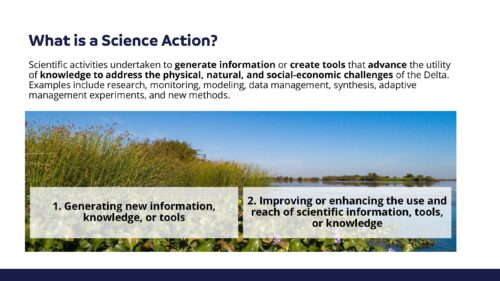 The Science Action Agenda assists the Delta science enterprise in prioritizing and aligning science actions to address management needs in the Delta. The document is critically important to guiding Delta science funding opportunities, including the Council’s proposal solicitation notices. In fact, the 2017-2021 SAA was used by the US Bureau of Reclamation, the California Department of Fish and Wildlife, the State Water Contractors, and the Delta Stewardship Council to allocate over $35 million to calls for research and fellowships. That science funding has, in turn, advanced the state of science and knowledge in the Delta and generated information critical to management, particularly as it relates to adaptive management, restoration, and applications of innovative and cost-effective methods for monitoring.
The Science Action Agenda assists the Delta science enterprise in prioritizing and aligning science actions to address management needs in the Delta. The document is critically important to guiding Delta science funding opportunities, including the Council’s proposal solicitation notices. In fact, the 2017-2021 SAA was used by the US Bureau of Reclamation, the California Department of Fish and Wildlife, the State Water Contractors, and the Delta Stewardship Council to allocate over $35 million to calls for research and fellowships. That science funding has, in turn, advanced the state of science and knowledge in the Delta and generated information critical to management, particularly as it relates to adaptive management, restoration, and applications of innovative and cost-effective methods for monitoring.
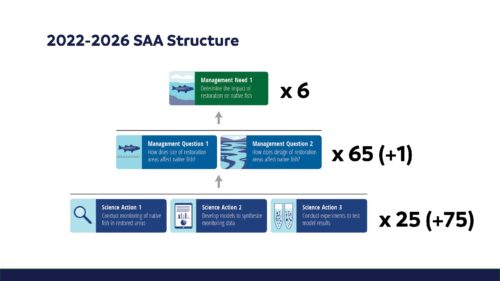 The actions in the 2022–2026 SAA work toward achieving an integrative understanding of the Delta at the landscape level and using that understanding to anticipate and plan for the future. Key policy objectives potentially advanced by the 2022–2026 SAA include improved invasive species management, climate-resilient wetland restoration, native species recovery, improved governance for human health and well-being, and management of HABs.
The actions in the 2022–2026 SAA work toward achieving an integrative understanding of the Delta at the landscape level and using that understanding to anticipate and plan for the future. Key policy objectives potentially advanced by the 2022–2026 SAA include improved invasive species management, climate-resilient wetland restoration, native species recovery, improved governance for human health and well-being, and management of HABs.
For more information on the Science Action Agenda, click here.
DISB presents the final review of the Delta monitoring enterprise
Members of the Delta Independent Science Board presented the release of the recently-completed ISB review of the Delta monitoring enterprise to the Council. Dr. Steve Brandt, current chair of the Delta Independent Science Board (DISB or Board), began with background on the DISB and its reviews.
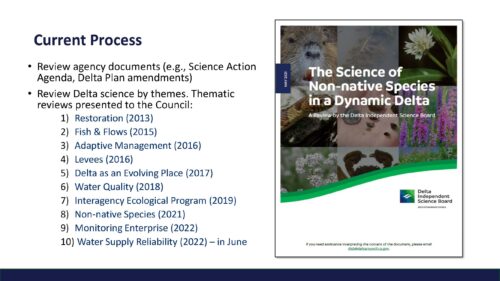 The Delta Reform Act gave the Board the responsibility to provide oversight of the scientific research, monitoring, and assessment programs that support adaptive management in the Delta. The DISB also provides independent advice on the Delta Plan and helps select the Delta Lead Scientist.
The Delta Reform Act gave the Board the responsibility to provide oversight of the scientific research, monitoring, and assessment programs that support adaptive management in the Delta. The DISB also provides independent advice on the Delta Plan and helps select the Delta Lead Scientist.
In doing this work, the Board reviews many documents, such as the Science Action Agenda, the Delta Science Plan, and the white papers developed for the Delta ecosystem amendments.
However, the Board’s primary responsibility is to review the science in the Delta. The Board does this by doing large-scale reviews on a thematic basis. The reviews completed to date are listed on the slide and include fish and flows, Delta as an evolving place, water quality, and non-native species.
The Board is here today to present their review of the monitoring enterprise in the Delta. In June, the Board will return to present their review on water supply reliability.
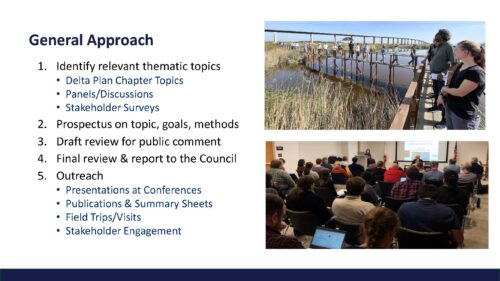 The purpose of the thematic reviews is to evaluate the state and adequacy of the science in the Delta. The DISB reviews are largely Delta-wide in perspective, strategic, and usually go beyond the responsibility of an individual agency. The recommendations are intended to address the needs for long-term goals and management in the Delta. He also noted that the Board does not recommend or endorse any policies to keep the science independent from policy decisions.
The purpose of the thematic reviews is to evaluate the state and adequacy of the science in the Delta. The DISB reviews are largely Delta-wide in perspective, strategic, and usually go beyond the responsibility of an individual agency. The recommendations are intended to address the needs for long-term goals and management in the Delta. He also noted that the Board does not recommend or endorse any policies to keep the science independent from policy decisions.
“They are very large-scale reviews,” said Dr. Brandt. “We want to identify the gaps, increase scientific credibility, improve research clarity, advance the state of debate about Delta issues, and seek better connectivity between science management and policy.
Topics for thematic reviews are identified by looking at the Delta Plan, conducting surveys, and having scientific panels and discussions. Once a topic is chosen, the Board writes a 2-3 page prospectus for public review. As the review is being drafted, there are further opportunities for public comment. Once finalized, the Board presents the report to the Council. The Board then works to encourage the recommendations to be adopted by giving presentations at meetings and conferences, publications, summary sheets, field trips, and other stakeholder engagement activities.
Method & process for the review
Dr. Harindra Fernando, a DISB member, then delved into the specifics of the process for the review. He began by defining monitoring as the measurement or collection of information to understand what is happening in the ecosystem. If it is done systematically and in a focused manner, it is called scientific monitoring. So the review of the Delta monitoring enterprise is basically a review of scientific monitoring.
The purpose of the review was to assess if the information collected from monitoring meets the needs of management agencies, how the coordination of monitoring between agencies could be improved, and how monitoring data can support the implementation of adaptive management, which depends on accurate monitoring data to be effective.
Dr. Fernando said that the monitoring enterprise in the Delta is very robust; the report identifies 157 different monitoring activities. So the review is extensive, the largest ever undertaken by the Board.
Monitoring was chosen as a topic to review because monitoring cuts across the whole Delta science fabric, said Dr. Fernando. “Everything the Delta science enterprise does involves monitoring. So it is essential that we understand the ecosystem’s status and functioning. Also, monitoring will give us an idea about the evolution and responses to management actions, and inform us of the changes in the drivers that change the environment.”
He also noted that the Delta Plan’s adaptive management process is highly dependent on monitoring, and monitoring is an essential component of science in the Delta.
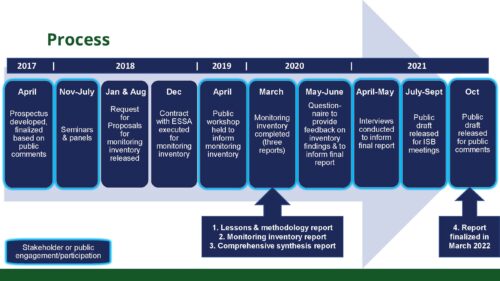 The review was initiated in April of 2017, completed in March of 2022, and consisted of two components.
The review was initiated in April of 2017, completed in March of 2022, and consisted of two components.
The first component was developing an inventory of all monitoring activities for physical, chemical, biological, geological, and social sciences in the Delta. It was a tedious task performed by a contractor over 15 months; the end product was an inventory report.
The second component was to take the information from the report and review it in the management context, garnering input from panels, webinars, public workshops, surveys, and interviews. The Board then produced a draft report which was subsequently circulated for public review and comment.
The management areas for the review were:
- Water supply management
- Flood management
- Habitat management
- Native species management
- Invasive species/non-native species management
- Water quality management
- Land use management
The graphic below shows the organizational framework for the drivers and conditions that affect environmental change in Delta. These include all the biological, physical, chemical, and geological attributes of Delta, environmental drivers and conditions, habitats and species, as well as the direct socioeconomic drivers of the environmental change.
The guiding questions for the review were:
- Are there potential gaps or redundancies in serving the relevant needs of decision-makers?
- What is the level of coordination of data collection across different organizations?
- Are there other opportunities to increase efficiencies in monitoring?
- Is the data quality of monitoring appropriate to address purposes & needs for information?
- Are data accessible to the public, decision-makers, other scientists & all stakeholders?
- What resources are dedicated to monitoring?
Findings
Dr. Tanya Heikkila then discussed the findings of the review.
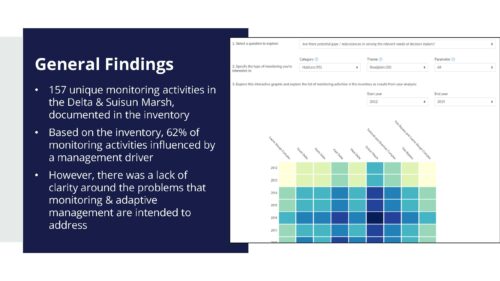 She noted that some of the general findings were related to the challenges of connecting monitoring activities to management.
She noted that some of the general findings were related to the challenges of connecting monitoring activities to management.
The inventory documented 157 unique monitoring activities in the Delta. Of those 157, 62% were influenced by a management driver. However, there was a lack of clarity around some of the problems that monitoring and adaptive management were intended to address.
The inventory will be made publicly available through the soon-to-be-launched Delta Science Tracker.
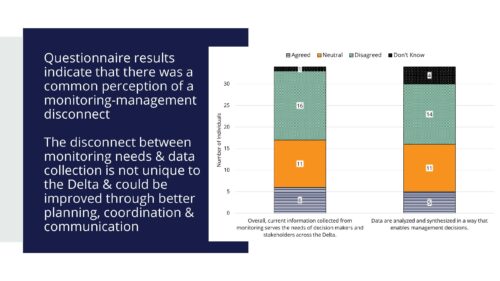 Questionnaires used in the interviews shed some light on the challenges between monitoring and management.
Questionnaires used in the interviews shed some light on the challenges between monitoring and management.
“One of the examples from the questionnaire results was that there is a common perception of a monitoring and management disconnect across the monitoring enterprise,” said Dr. Heikkila. “The disconnect between monitoring needs and data collection, although not unique to the Delta, could be improved through better planning, coordination, and communication.”
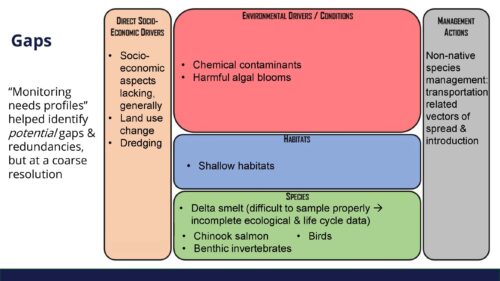 The review identified the areas that might not be adequately monitored and gaps across the monitoring enterprise, as well as potential redundancies in the monitoring activities. The slide shows some examples from their analysis organized in the framework presented earlier.
The review identified the areas that might not be adequately monitored and gaps across the monitoring enterprise, as well as potential redundancies in the monitoring activities. The slide shows some examples from their analysis organized in the framework presented earlier.
“While these gaps were identified, we didn’t have as fine of a resolution in understanding precisely the temporal issues around some of these gaps, for example, or some of the specific monitoring needs,” said Dr. Heikkila. “We would need to spend a little more time investigating to further identify those.”
She noted there’s a lot of variation in how much coordination happens in the monitoring enterprise across the different organizations and entities.
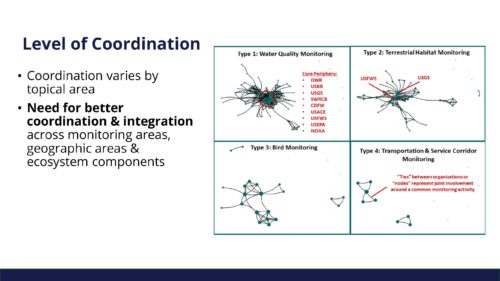 The four images on the slide illustrate the coordination of monitoring by topic areas, such as water quality monitoring, terrestrial habitat, and bird monitoring.
The four images on the slide illustrate the coordination of monitoring by topic areas, such as water quality monitoring, terrestrial habitat, and bird monitoring.
“There is more dense coordination in water quality monitoring than bird monitoring, for example,” she said. “So this analysis demonstrated a need for better coordination and integration across various monitoring areas, geographic areas, and certain ecosystem components.”
In terms of efficiencies in monitoring, the review found a need to increase the comparability of water quality monitoring parameters. This could include standardizing equipment use and calibration, employing more consistent sampling protocols, and centralizing data management.
There’s also a need to standardize habitat classification schemes to improve habitat monitoring coordination and incorporate some of the latest monitoring techniques and technologies available into the broader monitoring enterprise.
They found that 44% of the monitoring activities have publicly accessible data and data collection guided by a monitoring design or sampling protocol and adequate QA/QC procedures. However, there are still many monitoring activities that don’t have publicly accessible data.
So, although data accessibility has improved, more needs to be done to improve the availability and the timeliness of data sharing. Moreover, even when the data is available, the data are often hard to find or lack sufficient documentation, or are not available in a timely manner to conduct analysis.
Recommendations
The DISB provides several recommendations in the review.
The first set of recommendations focuses on guidelines for individual monitoring programs that are part of the Delta monitoring enterprise. Given the challenges in identifying adequate monitoring activities to answer management questions, the Board recommends developing an adaptive management framework for designing monitoring programs.
The graphic shows the steps of an adaptive management approach for developing a monitoring program. For each of the steps, there’s a set of detailed questions and approaches that need to be considered. It starts with defining the program’s purpose and encourages framing the problem in new ways. Then, consider how to design a monitoring program more explicitly around the problem, implement it, and learn from it as it proceeds, continually revising it as needed.
“Of course, these would have to be tailored to specific monitoring programs,” said Dr. Heikkila. “But we think this is an approach that can help address some of the disconnects between monitoring and management.”
The review provides general principles and best practices that all monitoring programs should consider. These include:
- formally tying monitoring to the questions, goals, and objectives of management;
- being informed by stakeholder needs and capabilities and including alternative forms of data and knowledge in monitoring programs;
- adapting as new information and technology become available;
- including data management, analysis, and synthesis; and
- ensuring data is accessible to a wide range of stakeholders, organizations, and individuals.
Finally, in addition to making recommendations for monitoring programs, the review includes cross-cutting recommendations that need to be considered for the monitoring enterprise as a whole.
“These are kind of the big move recommendations that we would like all of the entities involved in the monitoring enterprise to work towards,” she said. “These are not necessarily sequential; they interact and influence one another.”
Recommendation A focuses on developing management-informed priority science needs and questions that can help inform monitoring decisions. Recommendation B is to reimagine monitoring designs, then address those priority needs and questions. Finally, recommendation C is to strengthen the integration, funding, and organizational structure.
“There is no overarching monitoring organization in the Delta, and there is variation in how well coordinated many of the monitoring organizations are,” said Dr. Heikkila. “So we need to approach this from a coordination standpoint and develop more capacity across these entities to work with one another and collaborate on the various monitoring activities.”
Next steps
Dr. Brandt then wrapped up the presentation with the next steps. The DISB’s recommendations require collaboration and integration with the agencies to be adopted, so the Board is developing outreach efforts.
The Board has requested to present the results to the Delta Plan Interagency Implementation Committee (or DPIIC). The Board also is working with council staff and Delta Science Program to consider how they might move these recommendations forward, perhaps forming a workgroup via the Delta science program and DPIIC to review the recommendations and identify fruitful steps forward.
The Board is also considering producing a peer-reviewed journal publication that will reach the scientific community within the Delta and across the nation. And the Board plans to continue the conversations with various groups that do the monitoring and see if their recommendations might help them improve their programs. The Board will also continue the discussions with other groups, such as the Collaborative Adaptive Management Team and IEP.
A summary of the review is below. Click here for the full review.
2022-04-28-isb-monitoring-enterprise-review-summary


